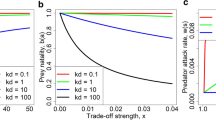Summary
An optimal age-structured life history is perturbed by increasing the mortality factors specific to an agek. These can be density dependent (DD) or independent (DI), avoidable or unavoidable. The last two refer to whether their effect on any individual depends or not on how much energy it devotes to defence. Agespecific trade-offs between the allocation of energy to defence and fecundity exist: survival probabilities through each agex, P x, are concave decreasing functions of the fecundity per unit size at that age,b x. These are constraints for the optimal life history. The changes induced by perturbation are evaluated by equations that predict whether some extra energy is diverted towards survivorship at the expense of fecundity or vice versa. The model predicts that for DI environments the degree of avoidability of the mortality source perturbed, is a decisive factor for the strategy selected at agek, but not for any other age class. DD environments are more complex since all ages are simultaneously embedded in density effects. The perturbations not only act directly — as in the DI situation — but also indirectly through their effect on equilibrium density,N *. When any kind of mortality source becomes more intense at agek, N * always decreases and all ages react in consequence according to the effect of density on each age-specific trade-off. Either coincidental or opposing reactions can be expected from direct and indirect effects. The resultant strategy for any age would be a matter of magnitude comparisons. Some possible general patterns are discussed.
Similar content being viewed by others
References
Brown, J.S. and Venable, D.L. (1986) Evolutionary ecology of seed-bank annuals in temporally varying environments.Am. Nat. 127 31–47.
Caswell, H. and Real, L.A. (1987) An approach to the perturbation analysis of optimal life histories.Ecology 68 1045–50.
Charlesworth, B. (1972) Selection in populations with overlapping generations. III. Conditions for genetic equilibrium.Theor. Pop. Biol. 3 377–95.
Charlesworth, B. (1980)Evolution in Aged-structured Populations. Cambridge University Press, Cambridge, UK.
Charlesworth, B. and León, J.A. (1976) The relation of reproductive effort to age.Am. Nat. 110 449–59.
Ganmatcher, F.R. (1959)The Theory of Matrices. Chelsea Publishing Company, NY, USA.
Gilpin, M.E. and Ayala, F.J. (1973) Global models of growth and competition.Proc. Natl. Acad. Sci. USA 70 3590–3.
Goodman, D. (1979) Regulating reproductive effort in a changing environment.Am. Nat. 113 735–48.
Harvey, P.H. and Pagel, M. (1991)The Comparative Method in Evolutionary Biology. Oxford University Press, Oxford, UK.
Henderson, J.M. and Quandt, R.E. (1971)Microeconomic Theory: A Mathematical Approach. McGraw-Hill, NY, USA.
Law, R. (1979) Optimal life histories under age-specific predation.Am. Nat. 114 399–417.
León, J.A. (1983) Compensatory strategies of energy investment in uncertain environments. InPopulation biology (H.E. Freedman and C. Strobeck, eds), pp. 85–90. Springer-Verlag, Berlin.
León, J.A. (1988) Avoidable mortality in life history theory. InMathematical ecology. 2nd research seminar (T. Hallam, L. Gross and S. Levin, eds), pp. 85–98. World Scientific, Singapore.
León, J.A. (1993) Plasticity in fluctuating environments. InAdaptation in stochastic environments (J. Yoshimura and C.W. Clark, eds), pp. 105–21. Springer-Verlag, Berlin.
Levins, R. (1968)Evolution in Changing Environments. Princeton University Press, Princeton, USA.
Lloyd, D.G. (1988) A general principle for the allocation of limited resources.Evol. Ecol. 2 175–87.
Maynard Smith, J. (1974) The theory of games and the evolution of animal conflict.J. Theor. Biol. 47 209–21.
Maynard Smith, J. (1978) Optimization theory in evolution.Ann. Rev. Ecol. Syst. 9 31–56.
Maynard Smith, J. and Price, G.R. (1973) The logic of animal conflicts.Nature 246 15–18.
Michod, R.E. (1979) Evolution of life histories in response to age-specific mortality factors.Am. Nat. 113 531–50.
Minchella, D.J. (1985) Host life-history variation in response to parasitism.Parasitology 90 205–16.
Minchella, D.J. and Loverde, P.T. (1981) A cost of increased early reproductive effort in the snailBiomphalaria glabrata.Am. Nat. 118 876–81.
Parker, G.A. and Maynard Smith, J. (1990). Optimality theory in evolutionary biology.Nature 348 27–33.
Reznick, D.N. (1982) The impact of predation on life history evolution in Trinidadian guppies: genetic basis of observed life history patterns.Evolution 36 1236–50.
Reznick, D.N. (1989) Life history-evolution in guppies: 2. Repeatability of field observations and the effects of season on life histories.Evolution 43 1285–97.
Reznick, D.N. and Bryga, H. (1987) Life-history evolution in guppies (Poecilia reticulata): 1. Phenotypic and genetic changes in an introduction experiment.Evolution 41 1370–85.
Reznick, D.N. and Endler, J.A. (1982) The impact of predation on life history evolution in Trinidadian guppies (Poecilia reticulata).Evolution 36 160–77.
Reznick, D.N., Bryga, H. and Endler, J.A. (1990) Experimentally induced life-history evolution in a natural population.Nature 346 357–9.
Schaffer, W.M. (1974) Selection of optimal life histories: the effects of age structure.Ecology 55 291–303.
Schaffer, W.M. (1979) Equivalence of maximizing reproductive value and fitness in the case of reproductive strategies.Proc. Natl Acad. Sci. USA 76 3567–9.
Stearns, S.C. (1989) The evolutionary significance of phenotypic plasticity.Bioscience 39 436–45.
Stearns, S.C. and Koella, J.C. (1986) The evolution of phenotypic plasticity in life-history traits: predictions of reaction norms for age and size at maturity.Evolution 40 893–913.
Yodzis, P. (1989)Introduction to Theoretical Ecology. Harper & Row, NY, USA.
Author information
Authors and Affiliations
Rights and permissions
About this article
Cite this article
Hernandez, MJ., León, J.A. Evolutionary perturbations of optimal life histories. Evol Ecol 9, 478–494 (1995). https://doi.org/10.1007/BF01237830
Issue Date:
DOI: https://doi.org/10.1007/BF01237830



